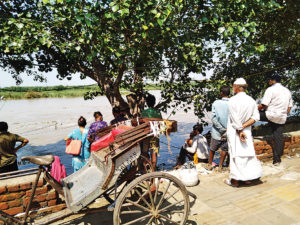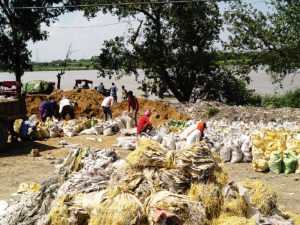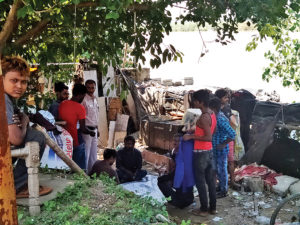Six thousand people living in the margins of Delhi’s floodplains are temporarily uprooted. Their lives are on hold until the waters recede
As heavy rains ravage many states in North India, a flood alert was issued earlier this week in parts of Delhi, Haryana, Punjab and Uttar Pradesh. The Delhi government issued an advisory stating, “People in low-lying areas to vacate their place as the water level neared warning level in the Yamuna river.”
Every year, the Delhi government sets up tents along with food, medical and sanitation facilities for people who live in low lying areas. But who are these people and why do they need to live right at the edge of the banks of Yamuna river? When this Newslaundry correspondent visited these flood-prone areas of Delhi — which includes Nighambodh Ghat, Yamuna Bazar and Kisan Basti — it was revealed that residents of these areas predominantly live in poverty.
It is the catastrophic aftermaths of floods that has hit these people hard. On August 24, the level of Yamuna was below the danger level. When this Newslaundry correspondent went to Kisan Basti in North East Delhi, she was told by the Supervisor of The International Civil Defence Organisation, Kamal Jyoti, that nearly 250 tents had been set up in the area.

Kamal Jyoti and Ishwar Singh from Civil Defence were deployed by the Disaster Management team to supervise. Jyoti said, “After floods, the government decides what amount of compensation should be given to these people.”
Pati Ram Mishra, a rickshaw puller in his early forties, stays in Kisan Basti with his wife and daughter. Mishra’s house gets submerged every year. He has been rebuilding his hut after the floods every year since the last three years.
Mishra came to Delhi 25 years ago from Kushinagar (UP) to find employment in a polythene factory where his friend worked. He did not have a stable source of income in Kushinagar, where he was working as daily wage labour. Initially, even Delhi turned out to be unfruitful for Mishra. While he managed to get a job at the same factory as his friend, Mishra neither understood the work nor knew how to operate machines. As a result, he left the factory. His friend asked him to go back but Mishra refused. He asked his friend to help him to get a rickshaw and ever since he has been working as a rickshaw-puller.
Initially Mishra lived in Mangolpuri with his wife but he had to pay Rs 1000 as rent for his jhuggi there. He decided to relocate to Krishna Basti a few years ago.
Mishra said, “Har saal badh aati hai aur har saal jhuggi banani padthi hai,”(Every year, after the floods, I have to rebuild my hut). He said the government gives all kinds of facilities in the tents but he barely receives any assistance for rebuilding his hut, except for a mosquito net and a tarpaulin.
Mishra’s daughter is in second grade in a nearby government school. He said the school remains closed during the floods.

Mishra said, “To build a new jhuggi I have to arrange bamboo sticks from the forest and few iron rods from here and there. I also have to borrow money.” He further adds, “Mein single hota to kahi bhi reh leta but family ke sath hun to ghar to lagega.’’ (Had I been single I could’ve lived anywhere but with family, I need a house).
The families who were relocated to these tents had a common complaint. Every year their jhuggis get submerged in water. Though the government sets up tents along with food, medical and sanitation facilities but once the water level subsides, the tents are removed and they have to rebuild their huts. This costs them a lot of money. Even the children here cannot go to school since the road to their school is also submerged in water.
When this correspondent asked Avatar Singh (representing Kalkaji for Aam Aadmi Party) if these people were compensated last year after the floods, he replied: “I think government along with the district magistrate decides on the compensation”.
Guddi Begam is a middle-aged woman with five children (three sons and two daughters). Her slum was submerged in water and she is now living in one of the rehabilitation tents. “Jo mera aadmi rikshaw chala ke kamata hai ussi paiso se har saal ek nayi juggi banani padhti hai. Sarkar hame kuch nahi deti (Every year we have to build a new slum from the money my husband earns from pulling rickshaws. The government does not give us anything),” she says.
Her second child Shabana, who is in seventh grade in a government school and aspires to become a teacher says, “Every year during the floods I have to miss my school as the road which leads to the schools remains submerged in water. Sometimes I even have to miss my exams.”
On August 18, 8.2 lakh cusecs of water were released from Haryana’s Hathni Kundi to the Yamuna, which led to the rise in the water level to 206.29 metres in Delhi. “Anything below the warning level which is 204.50 metres is considered normal,” explains Rajendra Singh, a junior engineer at the Department of Irrigation and Flood Control, Delhi.

Next day, Delhi Chief Minister Arvind Kejriwal called for a meeting where he appealed to people living in low-lying areas to move to tents which are being put up for their safety. He stated in a press conference that 2,120 tents have been put up along with food, water and medical facilities.
Despite the government’s urging, Newslaundry noticed the contrary during a visit on August 20, to Yamuna Bazaar near Nili Chatri which falls under Central Delhi’s Kothwali sub-division, where none of the residents was evacuated. The residents around Yamuna ghat predominantly live in poverty and stay in slums. When asked why they haven’t moved, the response was common, “Hum to sadak ke log hai hume kya farak padhta hai ek sadak se dusre sadhak pe jaane pe.’’ (We live on the streets, so it doesn’t matter if we are moved from one street to the other).
A rickshaw-puller, Bhuran says, “Road wala log road pe hi reh jata hai” (People who live on the streets remain on the streets, forever).
The East Delhi Assistant District Magistrate Arun Gupta said, “We have taken a lot of measures: 6000 people have been evacuated from low-lying areas of East Delhi and have been shifted to the tents. All of them are along the Yamuna river belt. 1,200 tents have been put up in 14 locations. They have drinking water, three meals every day and medical facilities.
He added, “We are better prepared than 2013. We have more updated information about the water level. Our actions are way more precise and appropriate.”
www.newslaundry.com





